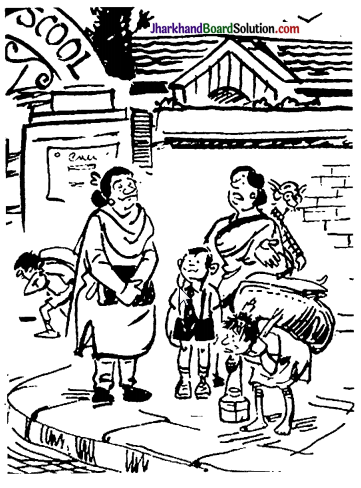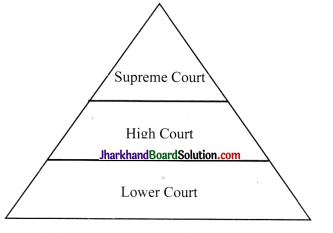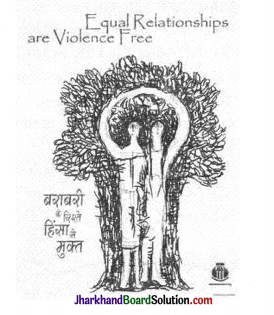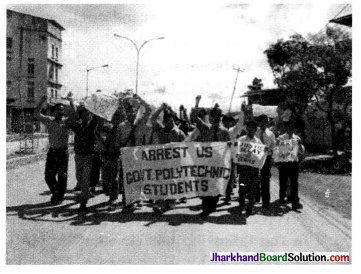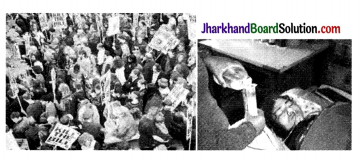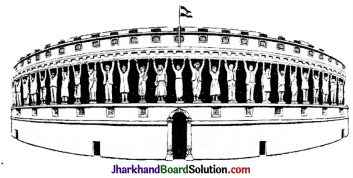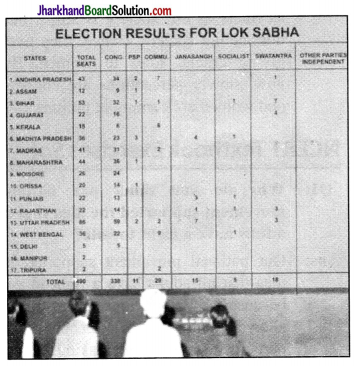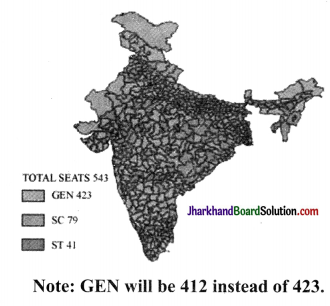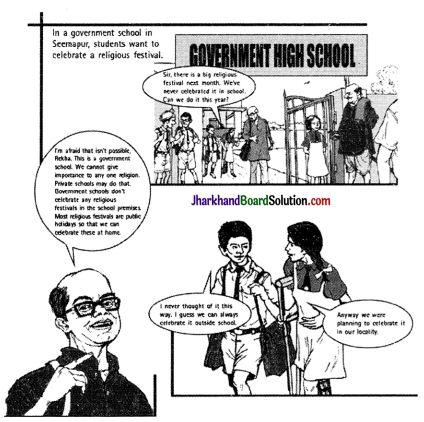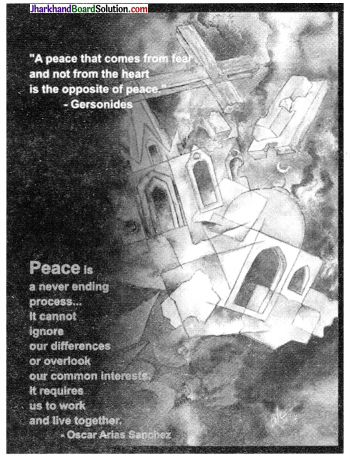JAC Board Class 8th Social Science Solutions Civics Chapter 9 Public Facilities
JAC Class 8th Civics Public FacilitiesInText Questions and Answers
Page 108
Question 1.
You have seen the four situations illustrated above (See NCERT page 106-107). Based on these, what impression do you get of the water situation in Chennai?
Answer:
From these four situations, we get the impression of the water situation in Chennai is that the water supply is not same for all the areas. There is a shortage of supply and demand is very high. As a result of this, only those who can afford to pay for water have sufficient access and those who can’t faces many difficulties.

Question 2.
Pick out the various sources of water for household use from the description alongside (See NCERT page 108).
Answer:
The various sources of water for household use from the description alongside are municipal water, water tanker, private borewell.
Question 3.
What, in your view, is similar, and what is different in Subramanian’s and Padma’s experiences.
Answer:
Similarities in Subramanian’s and Padma’s experiences are as follow:
- Both use borewell water
- Water shortage problem both of them.
- Both get water from tankers.
The differences are:
- Subramanian gets municipal water once in two days whereas, Padma does not have a tap connection.
- Subramanian spends upto ? 500/- on buying water from the tankers.
- Subramanian uses borewell water for washing and sanitation purposes whereas, Padma uses borewell water drinking and washing.
Question 4.
Write a paragraph describing the water supply situation in your area.
Answer:
Students need to do it on their own.
Question 5.
Why does water flow in a trickle in summer in most places in India? Find out.
Answer:
Water flow in a trickle in summer in most places in India because the demand for water is higher and supply is limited. The underground water level also goes down in summer due to hot weather and yield less water.

Question 6.
Discuss: Is there a general shortage of water for everyone in Chennai? Can you think of two reasons why different people get varying amounts of water?
Answer:
Yes, there is a general shortage of water for everyone in Chennai. Two reasons why different people get varying amounts of water are as follows:
- Different financial status, some are rich, some are poor.
- More demand and less supply.
Page 111
Question 7.
As Amu and Kumar ride around Chennai…
Amu:
Did you notice that the roads in Saidapet were so bumpy and without streetlights? / wonder what the place is like at night.
Kumar:
What better can you expect in a slum!
Amu:
Why should slums be like that? Shouldn’t they have public facilities?
Kumar: I think public facilities are for all those who live in proper houses in colonies. They are the people who pay taxes.
Amu: Why do you say that! Slum dwellers are also citizens and they have rights too.
Kumar: Arrey! The government will go bankrupt this way!
Amu: Well, it has to find a way. Can you imagine what it would be like to live in a slum without proper roads, water, electricity?
Kumar: Err….
Amu: Our Constitution recognises many of the public facilities as being a part of the Right to Life. The government must see that these rights are protected so that everyone can lead a decent life. point of view do you agree Whose with?
Answer:
I agree with Amu’s point of view.
Page 114
Question 8.
Discuss:
Do you think this would be a right step? (See NCERT page 114) What do you think would happen if the government withdraws from the task of supplying water?
Answer:
I don’t think it would be a right step. If the government withdraws from the task of supplying water then it would fail to perform its duty and many people will face serious problems. If the private companies take over the task of supplying water then they would look for more profit rather than thinking about the poor people who cannot afford to buy water. Government’s task is to ensure public facilities to all.
Question 9.
Discuss the main ideas in the above section (See NCERT page 115). What do you think can be done to improve water supply?
Answer:
This section dealt with the successful example of public water supply in Brazil and unsuccessful example of water supply in Bolivia. It also gave details about the better conditions of water supply in Mumbai and Hyderabad. Chennai has also taken steps in rain harvesting process. To improve the water supply certain steps can be taken such as afforestation, rain harvesting, repairing of water pipes, etc.
Question 10.
Do you think it is also important to conserve resources like water and electricity, and to use more public transport?
Answer:
Yes, it is also important to conserve resources like water and electricity, and to use more public transport.
Page 116
Question 11.
Do you think that lack of access to proper sanitation facilities affects peoples’ lives? How?
Answer:
Yes, lack of access to proper sanitation facilities affects peoples’ lives. It directly affects the health of the people and will become victims of many diseases like dysentery, cholera, etc. They won’t be able to work efficiently due to poor health conditions.

Question 12.
Why do you think that this would impact women and girls more acutely?
Answer:
This would impact women and girls more acutely because they are given less attention most of the time.
JAC Class 8th Civics Public Facilities Textbook Questions and Answers
Question 1.
Why do you think there are so few cases of private water supply in the world?
Answer:
There are so few cases of private water supply in the world because water is a basic necessity of life and everyone should get access to safe drinking water either free or at affordable rates. It is the government’s responsibility to provide water to everyone. Private companies work towards the only goal of maximising profits. If the responsibility of water supply is handed over to private companies, there would be a steep rise in the price of water, making it unaffordable for many.
Question 2.
Do you think water in Chennai is available to and affordable by all? Discuss.
Answer:
Water in Chennai is not available to and affordable by all. There is an unequal distribution of water in different parts of the city. Certain areas like Anna Nagar receive abundant water while areas like Mylapore get very little water. Municipal supply fails to meet the demand of water in the city.
People from the upper class and middle class buy packaged drinking water or water from tankers. But the situation is different and worst for the poor people as they cannot afford the expense of tankers or packaged water. In the slum areas, water supply runs for barely an hour every day and that too from a single tap that serves over thirty families for all their water needs.
Question 3.
How is the sale of water by farmers to water dealers in Chennai affecting the local people? Do you think local people can object to such exploitation of ground water? Can the government do anything in this regard?
Answer:
Due to the water shortage in Chennai, many private companies have taken it as an opportunity to earn huge profits by selling water in the city. The water is taken from nearby towns and from villages to the north of the city using a fleet of over 13,000 water tankers.
Every month the water dealers pay farmers an advance for the rights to exploit water sources on their land.Due to this trade, the water levels have dropped drastically in all these towns and villages. The water that is taken away from the farms is creating a deficit not only for irrigation but also for drinking water for the villagers.
Yes, the local people can object to such exploitation of ground water because water is a necessity and everyone has equal right to access it. The government should take a strict action against such offensive activities and disallow private companies from buying and supplying water.

Question 4.
Why are most of the private hospitals and private schools located in major cities and not in towns or rural areas?
Answer:
Most of the private hospitals and private schools located in major cities and not in towns or rural areas because they offer their services at high prices to earn profits and these services are affordable only by the affluent dwellers in the city.
Question 5.
Do you think the distribution of public facilities in our country is adequate and fair? Give an example of your own to explain.
Answer:
No, I don’t think the distribution of public facilities in our country is adequate and fair. For example, people living in cities avail all facilities such as healthcare, electricity, public transport, etc., but these facilities are not available fully in smaller towns and villages. They face major crisis of certain things such as electricity, not have a well developed transport system.
Question 6.
Take some of the public facilities in your area, such as water, electricity, etc. Is there scope to improve these? What in your opinion should be done? Complete the table.
Answer:
| Water |
Is it available? |
How can it be improved? |
| Electricity |
Yes |
By making its supply available for all the day long and improve the quality of water. |
| Roads |
Yes |
By providing its supply for whole day and keep a check on its theft. |
| Public |
Yes |
Repairing of worn-out roads. |
| Transport |
Yes |
Increasing the frequency of the buses by making more buses on roads available. |
Question 7.
Are the above public facilities shared equally by all the people in your area? Elaborate.
Answer:
The above public facilities are not shared equally by all the people in my area. The people living in posh localities avail best facilities. But the people living in slum areas doesn’t have all the facilities. They have crisis of water and electricity. On the other hand, people living in posh areas hardly face any water or electricity crisis.
Question 8.
Data on some of the public facilities are collected as part of the Census. Discuss with your teacher when and how the Census is conducted.
Answer:
The census is conducted in every 10 years. It counts the population of the country means the detailed information are collected. This information is used to measure important things such as ratio of males and females, number of literate people, etc.

Question 9.
Private educational institutions:
schools, colleges, universities, technical and vocational training institutes are coming up in our country in a big way. On the other hand, educational institutes run by the government are becoming relatively less important. What do you think would be the impact of this? Discuss.
Answer:
The impact of this would be that the weaker sections of the society will be deprived of quality education and the end result of this disparity will be that only the rich will get good education from the private educational institutions while the poor would not be able to afford the same. Education is a basic need and necessity and there should be universal access to education.
The main motive of private education institutes is earning profits, they charge high fees which are affordable only by the affluent section of the society. Thus, the right to quality education is only fulfilled for the rich class. Similarly, if government education institutes are not up to the mark, then weaker sections are again deprived of quality education. This, in turn, results in the disparity of quality education between the rich and the poor.
JAC Class 8th Civics Public Facilities Important Questions and Answers
Multiple Choice Questions
Question 1.
The following is are considered to be a public facilities:
(a) water, health, and education
(b) health, hospital, and gas
(c) water, house, and car
(d) both a and b
Answer:
(a) water, health, and education
Question 2.
The chief feature of the public facilities is:
(a) Once it is provided, its benefits cannot be shared with other people.
(b) Once it is provided, its benefits cannot be taken in the future.
(c) Once it is provided, its benefits can be shared by several people.
(d) None of these
Answer:
(c) Once it is provided, its benefits can be shared by several people.
Question 3.
The government gets money from the:
(a) loan from foreign banks.
(b) loan from Indian banks.
(c) tax collected from the people.
(d) all of these
Answer:
(c) tax collected from the people.
Question 4.
The Constitution of India recognises the right to water as being a part of the under Article 21.
(a) Right to Equality
(b) Right to Education
(c) Right to Health
(d) Right to Life
Answer:
(d) Right to Life
Question 5.
The basic needs of human beings is / are ……..
(a) Healthcare
(b) Water
(c) Food
(d) All of these
Answer:
(d) All of these
Question 6.
Which of the following is the main source of water for poor people?
(a) Borewell water
(b) Water tanker
(c) Muncipal water
(d) Bottled water
Answer:
(b) Water tanker

Question 7.
The is a water borne disease.
(a) Dysentery
(b) Measles
(c) Flu
(d) Polio
Answer:
(a) Dysentery
Question 8.
……… is guaranteed for all children aged between 6-14 years.
(a) Right to Life
(b) Right to Education
(c) Right to Equality
(d) Cultural Right
Answer:
(b) Right to Education
Question 9.
……… is not a source of water in rural areas.
(a) Overhead tanks
(b) Wells
(c) Borewells
(d) Handpumps
Answer:
(a) Overhead tanks
Question 10.
According to the standard set by the urban water commission, the supply of water per person in an urban area should be about .
(a) 120 litres per day
(b) 140 litres per day
(c) 160 litres per day
(d) 135 litres per day
Answer:
(d) 135 litres per day
Very Short Answer Type Questions
Question 1. Mention few public facilities that are also provided by private companies.
Answer:
Few public facilities that are also provided by private companies are school, colleges, healthcare and transportation.
Question 2.
What is the reason for the maximum death among children in India?
Answer:
The reason for maximum death among children in India is caused by the water¬borne diseases.
Question 3.
Name some public facilities that are provided by the government.
Answer:
Public facilities that are provided by the government are healthcare, sanitation, electricity, public transport, roads, schools and colleges.
Question 4.
Which age group of children should get compulsory education according to ‘Right to Education’?
Answer:
The age group of 6 – 14 years of children should get compulsory education according to ‘Right to Education’?

Question 5.
Is right to safe drinking water a fundamental right?
Answer:
Yes. Right to water entitles everyone to sufficient, safe, acceptable, physically accessible and affordable water for personal and domestic use.
Question 6.
What is the role of government in public facilities?
Answer:
One of the most important roles of the government is to ensure that these public facilities are made available to everyone.
Question 7.
What do you mean by government budget?
Answer:
Government budget is an account of the expenses the government has made on its programmes and projects in the past year and how much it plans to spend in the coming year.
Question 81.
What is universal access to water?
Answer:
Universal access to water is the right of every person, whether rich or poor to have sufficient amounts of water to fulfill his/her daily needs at a price that he/she can afford.
Question 9.
Which NGO has been working for three decades to address the problem sanitation?
Answer:
The NGO that has been working for three decades to address the problem of sanitisation is Sulabh.
Question 10.
What do you think is regarded as a sign of failure of the government?
Answer:
A shortage of basic public amenities such as water, healthcare, electricity is taken as a sign of failure of the government.
Short Answer Type Questions
Question l.
What do you mean by sanitation?
Answer:
The provision of facilities for the safe disposal of human urine and faeces is known as sanitation. This is done by construction of toilets and pipes to carry the sewerage and treating the waste water. This is necessary so as to avoid contamination and diseases.
Question 2.
What is Right to Water?
Answer:
The right to water is recognised as being a part of the Right to Life under Article 21 of the Constitution of India. This implies that it is the right of every person whether rich or poor to have sufficient amounts of water to fulfill his/ her daily needs at a price that he/she can afford.

Question 3.
What do you mean by company?
Answer:
A form of business set up by people or by the government is known as a company. Those that are promoted and owned by individuals or groups are called private companies. For example, Reliance is a private company whereas SAIL is a company run by the government.
Question 4.
From where does the government get money for the public facilities?
Answer:
The main source of revenue for the government is the taxes collected from the people and the government is empowered to collect these taxes and use them for such programmes and projects. Such as to supply water, the government has to incur costs in pumping water, carrying it over long distances, laying down pipes for distribution, treating the water for impurities and finally collecting and treating waste water. It meets these expenses partly from the various taxes that it collects and partly by charging a price for water. This price is set so that most people can afford a certain minimum amount of water for daily use.
Question 5.
Why does a lack of proper sanitation affect women and girls more acutely?
Answer:
Lack of proper sanitation affects women and girls more acutely because they often have to wait until dark to go to the toilet. To avoid the need for such frequent toilet use, women often drink less water which causes severe health impacts.
Question 6.
When there is a shortage of public facilities say water then what type of situation arise?
Answer:
When there is a shortage of public facilities say water then the situation which arises is burden for the poor since the shortfalls which occur falls mostly on the poor. Though the middle class people able to cope with it like buying bottled water from private companies or by digging borewells. People who can afford it have safe drinking water but poor people are left out. The poor people faces the crisis the most.
Long Answer Type Questions
Question 1.
Write in brief the availability of water in different regions of Chennai.
Answer:
The availability of water in different regions of Chennai are:
(i) One of the posh area is Anna Nagar in Chennai. This area looks lush and full with greenery. Then lush greens are maintained by enough spraying of water. Bunglows of rich people have tap water for major part of the day. When the water supply is inadequate, these rich people speak to a senior official whom he knows in the municipal water board and a water tanker is easily arranged for their house.

(ii) Like most areas of the city, the middle class people, Subramanian’s apartments in Mylapore suffers from water shortage. Once in two days, this area gets municipal water. A private borewell meets some of the resident’s water needs but the water is brackish so the residents use it in their toilets and for washing. For other uses they purchase water from tankers. Water purifiers are installed at homes for drinking purposes.
(iii) Siva lives on a rented house in Madipakkam and gets water once in four days. There is acute shortage of water. For drinking, they buy bottled water.
(iv) Padma lives in the slum area in Saidapet and works as a domestic help. There is a cluster of hutment, which has neither a bathroom nor a tap connection. For 30 such hutments there is a common tap at one comer, in which water comes from a borewell for 20 minutes twice daily.
A family gets to fill a maximum of three buckets within this time. The same water is used for washing and drinking. In summer, the flow becomes a trickle, so that one family gets water only at the cost of another. People have to wait long hours for water tankers. There situation becomes more pathetic during summers.
